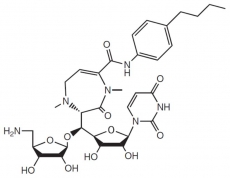CPZEN-45 is a nucleoside antibiotic that is soluble in water at >10 mg/mL as the trifluoroacetate salt. It is a caprazamycin produced by Streptomyces sp. first described in 2003 by investigators at the Microbial Chemistry Research Foundation (MCRF) and Meiji Seika Kaisa, Ltd of Japan. Subsequently, semi-synthetic production of novel antibiotics based on the caprazamycin structure was described in U.S. patent application US2006/017819 (which includes CPZEN-45 - designated compound II-4) and in a presentation at the 235th American Chemical Society National Meeting (2008) during which the structure of CPZEN-45 was first discussed in a public venue.
CPZEN-45 has a minimum inhibitory concentration (MIC) of 1.56 μg/mL against Mycobacterium tuberculosis (Mtb) H37Rv and 6.25 μg/mL against a multidrug resistant (MDR) strain of Mtb. This compound is active against both replicating and non-replicating Mtb in vitro, suggesting it could be efficacious against latent organisms in vivo. CPZEN-45 has shown efficacy against both drug sensitive and extremely drug resistant (XDR) Mtb in a mouse model of acute tuberculosis (TB) in which animals were infected by intravenous injection and treated with s.c. administration of CPZEN-45. Improved efficacy with drug sensitive Mtb was shown when CPZEN-45 was administered in combination with other antitubercular drugs. Data generated by NIAID using the gamma interferon gene-disrupted (GKO) mouse model of acute tuberculosis in which infection was achieved by aerosol exposure to Mtb (Erdman) demonstrated efficacy of CPZEN-45 with 1-1.5 log cfu reduction in lungs of infected mice.
Compound
CPZEN-45
Description
Related Links
- Biopharmaceutical in vitro characterization of CPZEN-45, a drug candidate for inhalation therapy of tuberculosis. Salomon JJ, Galeron P, Schulte N, Morow PR, Severynse-Stevens D, Huwer H, Daum N, Lehr CM, Hickey AJ, Ehrhardt C. Ther Deliv. 2013 Aug;4
- Lilly TB Drug Discovery Initiative
- Infectious Disease Research Institute
- IMC
- Inhibition of the first step in synthesis of the mycobacterial cell wall core, catalyzed by the GlcNAc-1-phosphate transferase WecA, by the novel caprazamycin derivative CPZEN-45. Ishizaki Y, Hayashi C, Inoue K, Igarashi M, Takahashi Y, Pujari V, Cri


